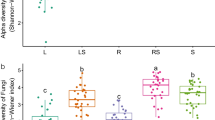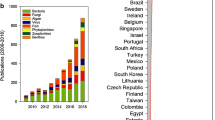Abstract
Monitoring bacterial communities is critical for assessing biodeterioration among other processes. This study presents a strategy and an example of comparative analysis of bacterial communities developing in a cave environment, Altamira Cave which contains unique paleolithic paintings. The analyzed question was whether white colonizations discovered throughout the cave corresponded to similar or different bacterial communities. Molecular fingerprints were obtained by PCR–DGGE from DNA and RNA and statistically compared. Results based on DNA analysis showed that a similar bacterial community was present in white colonizations throughout the cave. Fingerprints based on RNA confirmed the similarity of the major metabolically active components of these communities. The proposed procedure confirmed that white colonizations in Altamira Cave were a consequence of the development of a single complex bacterial community, and the method proves to be highly useful for comparative analysis of microbial communities, including biodeteriorating processes and any other comparative analysis of bacterial communities.



Similar content being viewed by others
References
Cañaveras JC, Sanchez-Moral S, Soler V, Saiz-Jimenez C (2001) Microorganisms and microbially induced fabrics in cave walls. Geomicrobiol J 18:223–240
Curtis TP, Sloan WT, Scannell JW (2002) Estimating prokaryotic diversity and its limits. Proc Natl Acad Sci USA 99:10494–10499
Fromin N, Hamelin J, Tarnawski S, Roesti D, Jourdain-Miserez K, Forestier N, Teyssier-Cuvelle S, Gillet F, Aragno M, Rossi P (2002) Statistical analysis of denaturing gel electrophoresis (DGE) fingerprinting patterns. Environ Microbiol 4:634–643
Gonzalez JM, Ortiz-Martinez A, Gonzalez-del Valle MA, Laiz L, Saiz-Jimenez C (2003) An efficient strategy for screening large cloned libraries of amplified 16S rDNA sequences from complex environmental communities. J Microbiol Meth 55:459–463
Gonzalez JM, Portillo MC, Saiz-Jimenez C (2006) Metabolically active Crenarchaeota in Altamira Cave. Naturwissenschaften 93:42–45
Gonzalez JM, Portillo MC, Saiz-Jimenez C (2008) Microbes pose a risk to prehistoric cave paintings. Microbe 3:72–77
Lasheras JA (2002) Redescubrir Altamira. Turner, Madrid
Liu WT, Martin TL, Cheng H, Formey LJ (1997) Characterization of microbial diversity by determining terminal restriction fragment length polymorphisms of genes encoding 16S rRNA. Appl Environ Microbiol 63:4516–4522
McCaig AE, Glover LA, Prosser JI (2001) Numerical analysis of grassland bacterial community structure under different land management regimens by using 16S ribosomal DNA sequence data and denaturing gradient gel electrophoresis banding patterns. Appl Environ Microbiol 67:4554–4559
Mills HJ, Martinez RJ, Story S, Sobecky PA (2004) Identification of members of the metabolically active microbial populations associated with Beggiatoa species. Appl Environ Microbiol 70:5447–5458
Molin S, Givskov M (1999) Application of molecular tools for in situ monitoring of bacterial growth activity. Environ Microbiol 1:383–391
Muyzer G, de Waal EC, Uitterlinden AG (1993) Profiling of complex microbial populations by denaturing gradient gel electrophoresis analysis of polymerase chain reaction-amplified genes coding for 16S rRNA. Appl Environ Microbiol 59:695–700
Peu P, Brugere H, Pourcher AM, Kerouredan M, Godon JJ, Delgenes JP, Dabert P (2006) Dynamics of a pig slurry microbial community during anaerobic storage and management. Appl Environ Microbiol 72:3578–3585
Portillo MC, Gonzalez JM (2008) Statistical differences between molecular fingerprints from microbial communities. Antonie Van Leeuwenhoek 94:157–163
Portillo MC, Gonzalez JM, Saiz-Jimenez C (2008) Metabolically active microbial communities of yellow and grey colonizations on the walls of Altamira Cave, Spain. J Appl Microbiol 104:681–691
Sanchez-Moral S, Soler V, Cañaveras JC, Sanz E, Van Grieken R, Gysells K (1999) Inorganic deterioration affecting Altamira Cave. Quantitative approach to wall-corrosion (solution etching) processes induced by visitors. Sci Total Environ 243:67–84
Schabereiter-Gurtner C, Saiz-Jimenez C, Piñar G, Lubitz W, Rölleke S (2002) Altamira cave Paleolithic paintings harbor partly unknown bacterial communities. FEMS Microbiol Lett 211:7–11
Schloss PD, Larget BR, Handelsman J (2004) Integration of microbial ecology and statistics: a test to compare gene libraries. Appl Environ Microbiol 70:5485–5492
Singleton DR, Furlong MA, Rathbun SL, Whitman WB (2001) Quantitative comparisons of 16S rRNA gene sequence libraries from environmental samples. Appl Environ Microbiol 67:4374–4376
Zimmermann J, Gonzalez JM, Ludwig W, Saiz-Jiménez C (2005) Detection and phylogenetic relationships of a highly diverse uncultured acidobacterial community on paleolithic paintings in Altamira Cave using 23S rRNA sequence analyses. Geomicrobiol J 22:379–388
Acknowledgments
The authors acknowledge support through a contract with the Ministry of Culture (Contract 31321000710T) and project CGL2006-11561/BTE from the Spanish Ministry of Education and Science. We acknowledge the encouragement from Dr. C. Saiz-Jimenez to pursue this study.
Author information
Authors and Affiliations
Corresponding author
Rights and permissions
About this article
Cite this article
Portillo, M.C., Gonzalez, J.M. Comparing bacterial community fingerprints from white colonizations in Altamira Cave (Spain). World J Microbiol Biotechnol 25, 1347–1352 (2009). https://doi.org/10.1007/s11274-009-0021-7
Received:
Accepted:
Published:
Issue Date:
DOI: https://doi.org/10.1007/s11274-009-0021-7




